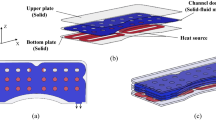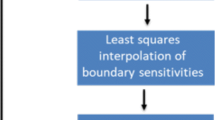Abstract
This paper demonstrates that there is much more to gain from topology optimization of heat sinks than what is described by the so-called pseudo 3D models. The utilization of 3D effects, even for microchannel heat sinks is investigated and compared to state-of-the art industrial designs, for a microelectronic application. Furthermore, the use of design restrictions in the optimization framework demonstrates that the performances of microchannel heat sinks are highly dependent on the ability to provide complex refrigerant distribution and intricate flow paths through the heat sink. The topology optimized microchannel heat sinks are exported from a voxel mesh to bodyfitted mesh using Trelis Sculpt and imported into a commercial CFD software. A systematic comparison with the state-of-the art industrial design shows that the temperature elevation of the microelectronic chip can be reduced by up to 70%, using a 3D topology optimized microchannel heat sink. Restricting the design freedom, for example, by limiting the solid features to be unidirectional downgrades the performances of the optimized microchannel heat sinks but still outperforms the reference case, for a similar design complexity.



















Similar content being viewed by others
References
Aage N, Andreassen E, Lazarov BS (2015) Topology optimization using PETSc: an easy-to-use, fully parallel, open source topology optimization framework. Struct Multidisc Optim 51(3):565–572. https://doi.org/10.1007/s00158-014-1157-0
Alexandersen J, Andreasen CS (2020) A review of topology optimisation for fluid-based problems. Fluids 5(1):29. https://doi.org/10.3390/fluids5010029
Alexandersen J, Sigmund O, Aage N (2016) Large scale three-dimensional topology optimisation of heat sinks cooled by natural convection. Int J Heat Mass Transf 100:876–891. https://doi.org/10.1016/j.ijheatmasstransfer.2016.05.013
Andreasen CS, Gersborg AR, Sigmund O (2009) Topology optimization of microfluidic mixers. Int J Numer Method Fluids 61(5):498–513. https://doi.org/10.1002/fld.1964
Balay S, Gropp WD, McInnes LC, Smith BF (1997) Efficient management of parallelism in object oriented numerical software libraries. In: Bruaset AM, Langtangen HP (eds) Arge E. Modern software tools in scientific computing. Birkhäuser Press, Basel, pp 163–202
Bendsøe M (1989) Optimal shape design as a material distribution problem. Struct Multidisc Optim 1(4):193–202. https://doi.org/10.1007/BF01650949
Borrvall T, Petersson J (2003) Topology optimization of fluids in Stokes flow. Int J Numer Method Fluids 41(1):77–107. https://doi.org/10.1002/fld.426
Brinkman HC (1947) A calculation of the viscous force exerted by a flowing fluid on a dense swarm of particles. Appl Sci Res Sect A 1(1):27–34
Dbouk T (2017) A review about the engineering design of optimal heat transfer systems using topology optimization. Appl Therm Eng 112:841–854. https://doi.org/10.1016/j.applthermaleng.2016.10.134
Dede EM (2012) Optimization and design of a multipass branching microchannel heat sink for electronics cooling. J Electron Packag Trans ASME 134(4):1–10. https://doi.org/10.1115/1.4007159
Dilgen SB, Dilgen CB, Fuhrman DR, Sigmund O, Lazarov BS (2018) Density based topology optimization of turbulent flow heat transfer systems. Struct Multidisc Optim 57(5):1905–1918. https://doi.org/10.1007/s00158-018-1967-6
DTU Computing Center (2021) DTU Computing Center resources. 10.48714/DTU.HPC.0001
Gersborg AR, Andreasen CS (2011) An explicit parameterization for casting constraints in gradient driven topology optimization. Struct Multidisc Optim 44(6):875–881. https://doi.org/10.1007/s00158-011-0632-0
Gersborg-Hansen A, Sigmund O, Haber R (2005) Topology optimization of channel flow problems. Struct Multidisc Optim 30(3):181–192. https://doi.org/10.1007/s00158-004-0508-7
Guest JK, Prévost JH, Belytschko T (2004) Achieving minimum length scale in topology optimization using nodal design variables and projection functions. Int J Numer Method Eng 61(2):238–254. https://doi.org/10.1002/nme.1064
Haertel JH, Engelbrecht K, Lazarov BS, Sigmund O (2018) Topology optimization of a pseudo 3D thermofluid heat sink model. Int J Heat Mass Transf 121:1073–1088. https://doi.org/10.1016/j.ijheatmasstransfer.2018.01.078
Han Xh, Hl Liu, Xie G, Sang L, Zhou J (2021) Topology optimization for spider web heat sinks for electronic cooling. Appl Therm Eng 195:117154
Høghøj LC, Nørhave DR, Alexandersen J, Sigmund O, Andreasen CS (2020) Topology optimization of two fluid heat exchangers. Int J Heat Mass Transf 163(June):120543. https://doi.org/10.1016/j.ijheatmasstransfer.2020.120543
Langelaar M (2018) Combined optimization of part topology, support structure layout and build orientation for additive manufacturing. Struct Multidisc Optim 57(5):1985–2004. https://doi.org/10.1007/s00158-017-1877-z
Lazarov BS, Sigmund O (2011) Filters in topology optimization based on Helmholtz-type differential equations. Int J Numer Method Eng 86(6):765–781. https://doi.org/10.1002/nme.3072
Lazarov BS, Sigmund O, Meyer KE, Alexandersen J (2018) Experimental validation of additively manufactured optimized shapes for passive cooling. Appl Energy. https://doi.org/10.1016/j.apenergy.2018.05.106
Li BT, Xie CH, Yin XX, Lu R, Ma Y, Liu HL, Hong J (2021) Multidisciplinary optimization of liquid cooled heat sinks with compound jet/channel structures arranged in a multipass configuration. Appl Therm Eng 195:117159. https://doi.org/10.1016/j.applthermaleng.2021.117159
Okkels F, Bruus H (2007) Scaling behavior of optimally structured catalytic microfluidic reactors. Phys Rev E 75(1):016301. https://doi.org/10.1103/PhysRevE.75.016301
Qasem NA, Zubair SM (2018) Compact and microchannel heat exchangers: a comprehensive review of air-side friction factor and heat transfer correlations. Energy Convers Manag 173(May):555–601. https://doi.org/10.1016/j.enconman.2018.06.104
Sigmund O (2007) Morphology-based black and white filters for topology optimization. Struct Multidisc Optim 33(4–5):401–424
Stolpe M, Svanberg K (2001) An alternative interpolation scheme for minimum compliance topology optimization. Struct Multidisc Optim 22(2):116–124. https://doi.org/10.1007/s001580100129
Sun S, Liebersbach P, Qian X (2020) 3D topology optimization of heat sinks for liquid cooling. Appl Therm Eng 178:115540. https://doi.org/10.1016/j.applthermaleng.2020.115540
Tezduyar TE, Ramakrishnan S, Sathe S (2008) Stabilized formulations for incompressible flows with thermal coupling. Int J Numer Method Fluids 57(9):1189–1209. https://doi.org/10.1002/fld.1743
Wang F, Lazarov BS, Sigmund O (2011) On projection methods, convergence and robust formulations in topology optimization. Struct Multidisc Optim 43(6):767–784. https://doi.org/10.1007/s00158-010-0602-y
Yan S, Wang F, Hong J, Sigmund O (2019) Topology optimization of microchannel heat sinks using a two-layer model. Int J Heat Mass Transf 143:118462. https://doi.org/10.1016/j.ijheatmasstransfer.2019.118462
Yoon GH (2010) Topological design of heat dissipating structure with forced convective heat transfer. J Mech Sci Technol 24(6):1225–1233. https://doi.org/10.1007/s12206-010-0328-1
Zeng S, Lee PS (2019) Topology optimization of liquid-cooled microchannel heat sinks: an experimental and numerical study. Int J Heat Mass Transf 142:118401. https://doi.org/10.1016/j.ijheatmasstransfer.2019.07.051
Acknowledgements
This work is a part of the project EASY-E: Thermal Topology Optimization made Easily accessible (Grant Number 64020-1026) financially supported by the Danish Energy Agency (EUDP program). The authors acknowledge the members of the TopOpt group from DTU MEK for fruitful discussions.
Author information
Authors and Affiliations
Corresponding author
Ethics declarations
Conflict of interest
The authors declare that they have no confict of interest.
Replication of results
The authors will provide the full set of input parameters, methods, and results upon request. Any topology optimization framework based on FEM with an implementation of the approach described in this paper should be able to reproduce the results. A complete description of the export of optimized geometries can also be produced on demand.
Additional information
Responsible Editor: Kentaro Yaji
Publisher’s Note
Springer Nature remains neutral with regard to jurisdictional claims in published maps and institutional affiliations.
Topical Collection: Flow-driven Multiphysics
Guest Editors: J Alexandersen, C S Andreasen, K Giannakoglou, K Maute, K Yaji.
Appendices
Appendices
1.1 Sensitives for conjugate heat transfer
In the case of a conjugate heat transfer problem, the objective function is dependent on the density field \(\xi\) but also on the velocity and pressure field \({\mathbf {u}}(\xi )\) and the temperature field \({\mathbf {T}}(\xi )\).
Using the chain rule, the derivative of the objective function in respect to the density field is expressed by
The Lagrangian function \({\mathcal {L}}\) is introduced alongside the Lagrangian multipliers and their respective residual functions.
The residual terms being by definition null or close to zero, the Lagrangian formulation is used to bypass the calculation of the difficult terms of Eq. A.1.2. Using the chain rule, the derivative of the Lagrangian function in respect to the density field is expressed by
Since forced convection is the predominant heat transfer phenomena, there only exists a one-way coupling where the fluid residuals in respect of the temperature are assumed to be zero.
By regrouping the terms of Eq. A.1.4, the sensitivity of the Lagrangian function can be expressed as
The terms \(\frac{d{\mathbf {u}}}{d\xi }\) and \(\frac{d{\mathbf {T}}}{d\xi }\), difficult to evaluate, can be carefully eliminated from Eq. A.1.4 by choosing the adequate Lagrangian multipliers fulfilling the following two equality functions.
After solving the so-called backward problem, the Lagrangian multipliers can be plugged back to the Eq. A.1.4 leading to the final equation:
1.2 Evolution of optimization
Figure 20 represents the variation of the objective function value and the constraint functions value in respect of the iteration number, for the 3D optimized model with \(\eta = 0.5\).
First of all, the optimization terminates and is considered converged when the maximum amount of design change (or density change) becomes lower than 0.1%. The spikes and jumps in the evolution of the objective and constraint functions appear each time once the optimization parameter is subject to continuation. Overall, the optimization is rather smooth, expect for lower values of \(\beta\) where the optimization takes several iterations to stabilize. Fig. 20 also shows that the pressure constraint leads the optimization, whereas a volume fraction of 50% appears to be too generous to get an optimized geometry at the current pressure drop. Fig. 21 represents the evolution of the material distribution of the optimized heat sink at different stages of the optimization process.
1.3 Restricted optimized models
The temperature field, flow streamlines, and velocity profiles at different cross-sections of the optimized heat sinks are shown in Figs. 22 and 23. The flow field is similar with the non-projected 3D design, with the difference of having a single solid block with thicker features.
1.4 Regression models
The values of the objective using the interpolation model are plotted along the results of the CFD simulations (Fig. 24).
The power law regression model can fit all the data points of the CFD simulations, making it reliable for predicting data outside of the current pressure range, as long as the flow remains laminar.
Rights and permissions
Springer Nature or its licensor (e.g. a society or other partner) holds exclusive rights to this article under a publishing agreement with the author(s) or other rightsholder(s); author self-archiving of the accepted manuscript version of this article is solely governed by the terms of such publishing agreement and applicable law.
About this article
Cite this article
Rogié, B., Andreasen, C.S. Design complexity tradeoffs in topology optimization of forced convection laminar flow heat sinks. Struct Multidisc Optim 66, 6 (2023). https://doi.org/10.1007/s00158-022-03449-w
Received:
Accepted:
Published:
DOI: https://doi.org/10.1007/s00158-022-03449-w









